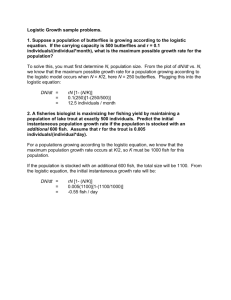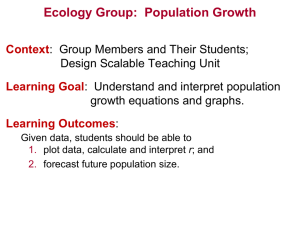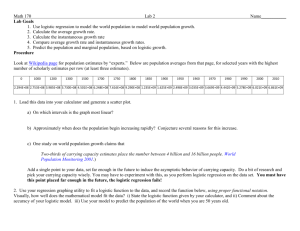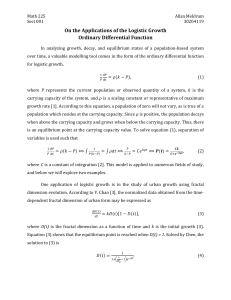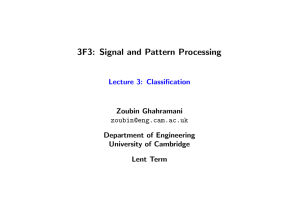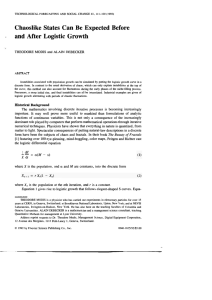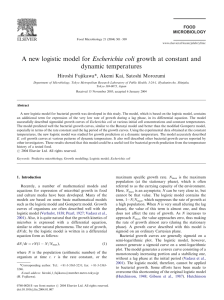on single-population models
advertisement
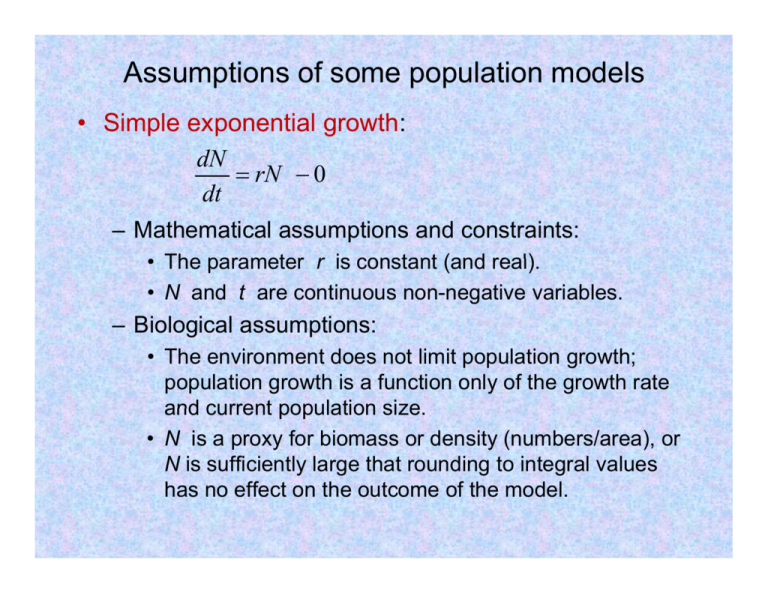
Assumptions of some population models • Simple exponential growth: dN rN 0 dt – Mathematical assumptions and constraints: • The parameter r is constant (and real) real). • N and t are continuous non-negative variables. – Biological g assumptions: p • The environment does not limit population growth; population growth is a function only of the growth rate and current population size. size • N is a proxy for biomass or density (numbers/area), or N is sufficiently large that rounding to integral values h no effect has ff t on the th outcome t off the th model. d l Assumptions of some population models • Monomolecular growth for reactant and product (resources and population size): R t C t A dR 0 kR, d dt dC kR 0 ddt – Mathematical assumptions and constraints: • Parameters A and k are constant and non-negative. non negative. • R, C, and t are continuous non-negative variables. – Biological assumptions: • The environment (A) is absolutely limiting. • R and C are proxies for concentrations of substances. – E.g., E g resources and biomass biomass. • One unit of R is converted to one unit of C. Assumptions of some population models • Logistic growth: rN 2 dN N rN 1 rN dt K K – Mathematical assumptions and constraints: • Parameters r and K are constant; K is positive. variables. • N and t are continuous non-negative variables – Biological assumptions: • The environment (K) is absolutely limiting. • N is a proxy for biomass or density (numbers/area), or N is sufficiently large that rounding to integral values has no effect on the outcome of the model. Birth and death processes • Population models in terms of birth and death: B = instantaneous birth rate (number of births/time) D = instantaneous death rate (number of deaths/time) • Unlimited (exponential) population growth: – Population growth rate r is just the difference between constant birth rate and constant death rate rate. dN BN DN dt B D N rN Birth and death processes • Li Limited it d (d (density-dependent) it d d t) population l ti growth: th dN BN N DN N dt BN f B N , DN f D N • For logistic growth: • Functions fB and fD are linear. B0 DN D0 dN b D0 r0 B0 D0 B0 D0 K bd d BN B0 bN • Many other kinds of functions are possible. Logistic model with time delay • Logistic model: instantaneous growth rate at a given instant is a function of the population size at that instant. • Implies that factors that limit population growth are assumed to act instantaneously on changes in populations size, with no time delay. • Realistically, there will be some delay (lag) before the effects of a factor due to changing population size are incorporated into the dynamics of the population population. • E.g., herbivore population may attain high numbers by overgrazing a pasture. – Will then decline due to food shortage until vegetation recovers from effects of overgrazing. • Time delay (lag) in response to limiting factors may lead to fluctuations in population size. Logistic model with time delay • Modify logistic model to include lag: – Let growth rate (and population size) at time t depend on population size at time (t-tlag). – Gives a delay-differential equation for rate of change of population size: N t tlag dN t rN t 1 d dt K – Can’t be solved (integrated) analytically. – Can use numerical integration methods. Logistic model with time delay • Ex: E th three series i corresponding di tto: r = 0.3, 1.2, 2.0 N0 = 2 2, K = 10 tlag = 1 • For increasing g r,, population p p trajectory j y changes: g – r = 0.3: Steady increase to equilibrium K. – r = 1.2: Damped oscillations converging on K. – r = 2.0: Sustained oscillations (limit cycle). Logistic model with time delay • Fluctuations in population size due to lag: – Occur because population can overshoot and fall below q before change g in g growth rate stems the equilibrium increase or decreases the decline. – Dynamic behavior of model depends on relative magnitudes it d of: f • Intrinsic rate of increase, r. • Time delay, tlag . – Interaction modeled by the product r tlag . 1 • 0 rtlag e • • e 1 rtlag 2 2 rtlag l :steady increase or decrease to equilibrium. :damped oscillations to equilibrium. :limit cycles with amplitude and frequency depending on rtlag . Logistic model with time delay • Behavior of model can be expressed in terms of characteristic return time: 1 Tr r = time taken to increase population size by a factor of e = 2.718…, 2 718 growing exponentially with rate constant r. r – If time lag is long relative to characteristic return time: • Population tends to overshoot and undershoot. • Leads to cyclical fluctuations. • Models with time lags can mimic fluctuations in natural populations (voles, red grouse, lynx). – Underlying biological mechanisms not well understood. Generalization of the logistic model • Logistic model assumes that birth and death rates change linearly with increasing population size. B0 DN D0 dN b D0 d BN B0 bN – Mathematical simplification (“model of ignorance”) – No biological rationale for this assumption assumption. – Several generalizations have been proposed. Generalizations of the logistic model Birth rate Pop pulation size N dN N rN 1 • 2-parameter logistic model: dt K 1 • 3-parameter generalization: dN rN 1 N K dt N 0 1 r t e • Solution: N t K 1 1 K Population size N Time Generalizations of the logistic model • Oth Other generalizations li ti allow ll ffor more complicated li t d cases: Birth rate Birth rate –E E.g., g Allee effect: finding mates is more difficult when population density is low. Population size N Population size N

